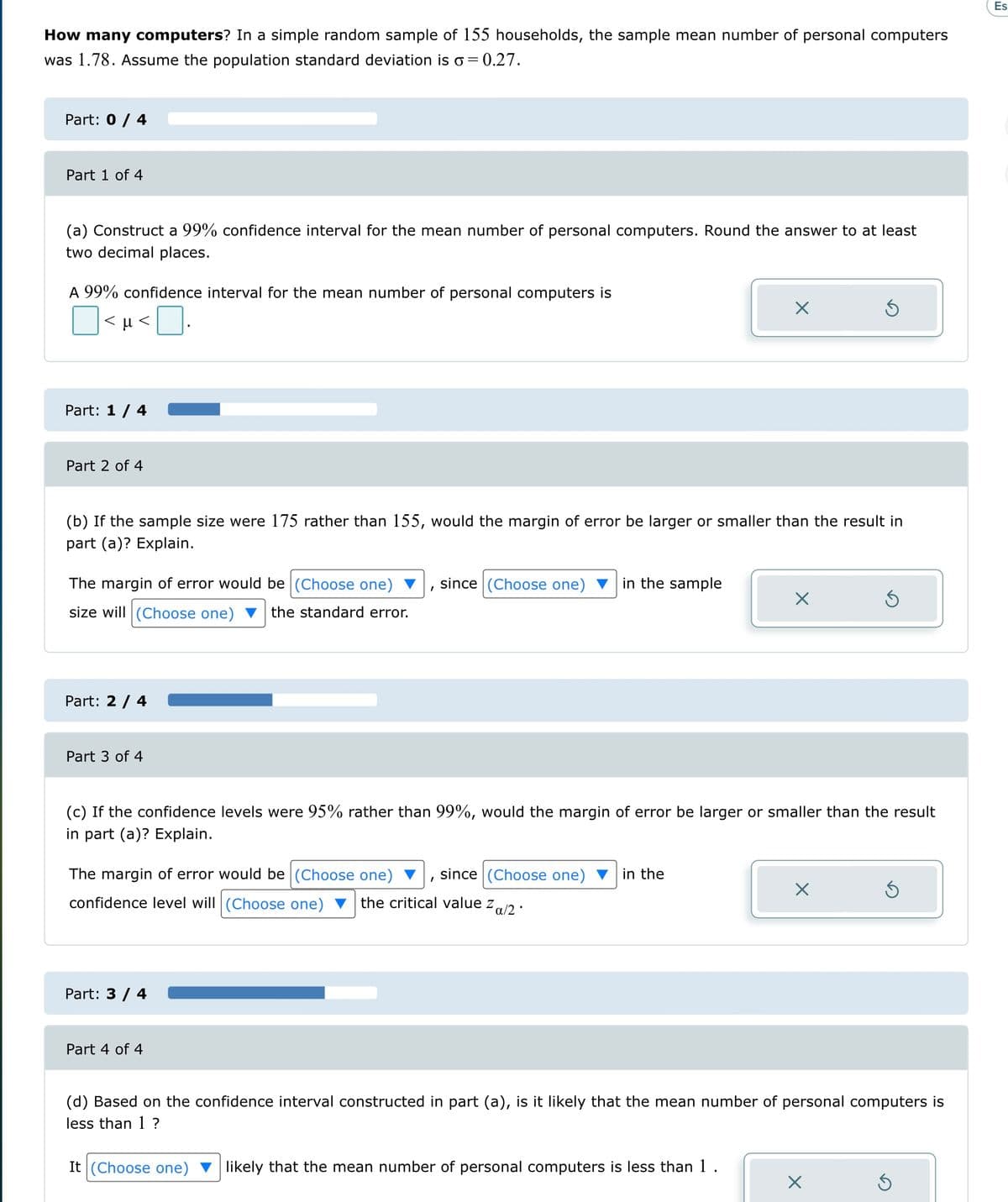How many computers? In a simple random sample of 155 households, the sample mean number of personal computers was 1.78. Assume the population standard deviation is o= 0.27. Part: 0 / 4 Part 1 of 4 (a) Construct a 99% confidence interval for the mean number of personal computers. Round the answer to at least two decimal places. A 99% confidence interval for the mean number of personal computers is <με Part: 1/4 Part 2 of 4 (b) If the sample size were 175 rather than 155, would the margin of error be larger or smaller than the result in part (a)? Explain. The margin of error would be (Choose one) ▼ since (Choose one) in the sample size will (Choose one) ▼ the standard error. Part: 2/4 Part 3 of 4 The margin of error would be (Choose one) ▼ since (Choose one) in the confidence level will (Choose one) the critical value zα/2. X (c) If the confidence levels were 95% rather than 99%, would the margin of error be larger or smaller than the result in part (a)? Explain. Part: 3/4 Part 4 of 4 X X (d) Based on the confidence interval constructed in part (a), is it likely that the mean number of personal computers is less than 1? It (Choose one) likely that the mean number of personal computers is less than 1. X
How many computers? In a simple random sample of 155 households, the sample mean number of personal computers was 1.78. Assume the population standard deviation is o= 0.27. Part: 0 / 4 Part 1 of 4 (a) Construct a 99% confidence interval for the mean number of personal computers. Round the answer to at least two decimal places. A 99% confidence interval for the mean number of personal computers is <με Part: 1/4 Part 2 of 4 (b) If the sample size were 175 rather than 155, would the margin of error be larger or smaller than the result in part (a)? Explain. The margin of error would be (Choose one) ▼ since (Choose one) in the sample size will (Choose one) ▼ the standard error. Part: 2/4 Part 3 of 4 The margin of error would be (Choose one) ▼ since (Choose one) in the confidence level will (Choose one) the critical value zα/2. X (c) If the confidence levels were 95% rather than 99%, would the margin of error be larger or smaller than the result in part (a)? Explain. Part: 3/4 Part 4 of 4 X X (d) Based on the confidence interval constructed in part (a), is it likely that the mean number of personal computers is less than 1? It (Choose one) likely that the mean number of personal computers is less than 1. X
MATLAB: An Introduction with Applications
6th Edition
ISBN:9781119256830
Author:Amos Gilat
Publisher:Amos Gilat
Chapter1: Starting With Matlab
Section: Chapter Questions
Problem 1P
Related questions
Question
100%

Transcribed Image Text:How many computers? In a simple random sample of 155 households, the sample mean number of personal computers
was 1.78. Assume the population standard deviation is o = 0.27.
Part: 0 / 4
Part 1 of 4
(a) Construct a 99% confidence interval for the mean number of personal computers. Round the answer to at least
two decimal places.
A 99% confidence interval for the mean number of personal computers is
<μ<
Part: 1 / 4
Part 2 of 4
The margin of error would be (Choose one)
size will (Choose one) the standard error.
(b) If the sample size were 175 rather than 155, would the margin of error be larger or smaller than the result in
part (a)? Explain.
Part: 2 / 4
Part 3 of 4
The margin of error would be (Choose one)
since (Choose one) in the
confidence level will (Choose one) the critical value z a/2*
Part: 3 / 4
since (Choose one) in the sample
(c) If the confidence levels were 95% rather than 99%, would the margin of error be larger or smaller than the result
in part (a)? Explain.
Part 4 of 4
X
I
Ś
X
X
Ś
(d) Based on the confidence interval constructed in part (a), is it likely that the mean number of personal computers is
less than 1 ?
It (Choose one) likely that the mean number of personal computers is less than 1.
S
Es
Expert Solution
This question has been solved!
Explore an expertly crafted, step-by-step solution for a thorough understanding of key concepts.
This is a popular solution!
Step 1: Given Information
VIEWStep 2: Computing 99% confidence interval for the mean
VIEWStep 3: Computing the margin of error for different sample sizes
VIEWStep 4: Computing the margin of error for different confidence levels
VIEWStep 5: Determining if the population mean is less than 1 using the 99% confidence interval
VIEWSolution
VIEWTrending now
This is a popular solution!
Step by step
Solved in 6 steps with 12 images

Recommended textbooks for you

MATLAB: An Introduction with Applications
Statistics
ISBN:
9781119256830
Author:
Amos Gilat
Publisher:
John Wiley & Sons Inc

Probability and Statistics for Engineering and th…
Statistics
ISBN:
9781305251809
Author:
Jay L. Devore
Publisher:
Cengage Learning

Statistics for The Behavioral Sciences (MindTap C…
Statistics
ISBN:
9781305504912
Author:
Frederick J Gravetter, Larry B. Wallnau
Publisher:
Cengage Learning

MATLAB: An Introduction with Applications
Statistics
ISBN:
9781119256830
Author:
Amos Gilat
Publisher:
John Wiley & Sons Inc

Probability and Statistics for Engineering and th…
Statistics
ISBN:
9781305251809
Author:
Jay L. Devore
Publisher:
Cengage Learning

Statistics for The Behavioral Sciences (MindTap C…
Statistics
ISBN:
9781305504912
Author:
Frederick J Gravetter, Larry B. Wallnau
Publisher:
Cengage Learning

Elementary Statistics: Picturing the World (7th E…
Statistics
ISBN:
9780134683416
Author:
Ron Larson, Betsy Farber
Publisher:
PEARSON

The Basic Practice of Statistics
Statistics
ISBN:
9781319042578
Author:
David S. Moore, William I. Notz, Michael A. Fligner
Publisher:
W. H. Freeman

Introduction to the Practice of Statistics
Statistics
ISBN:
9781319013387
Author:
David S. Moore, George P. McCabe, Bruce A. Craig
Publisher:
W. H. Freeman